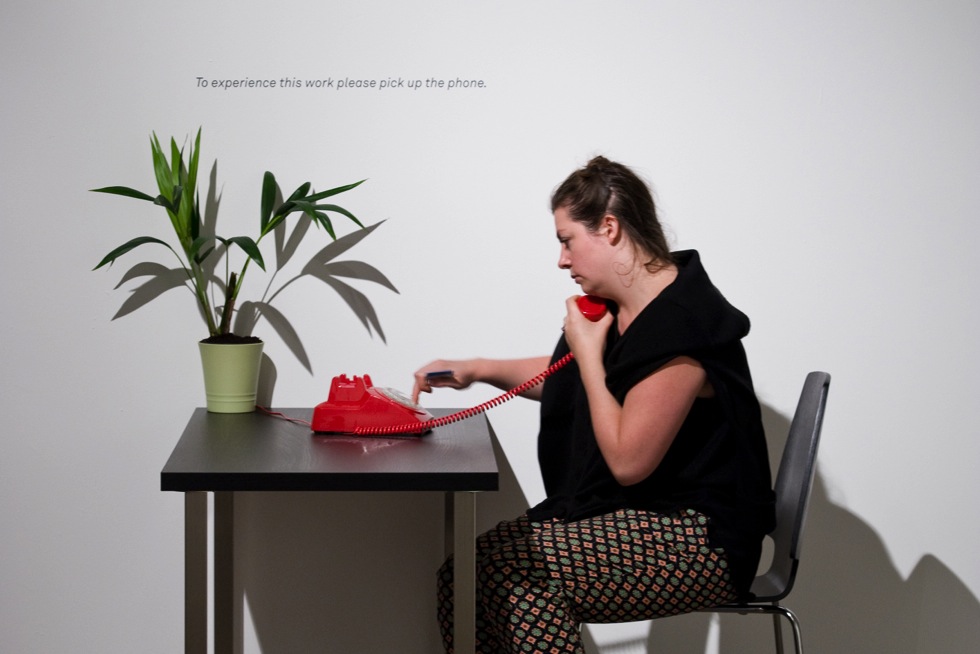Hear Here: The Act Of Listening

As Sam Belinfante’s Hayward Touring exhibition Listening travels to The Bluecoat, C. James Fagan ponders the differences between ‘hearing’ and ‘listening’ in the context of our contemporary lifestyles…
Since the human race emerged, we have been been hearing and listening — well, so I assume. Over that time, you have to consider the possibility that the way we undertake these perceptive acts has changed somehow. Has it? It would be difficult for us to pinpoint any change, as we were never privy to a single evolution, existing in a world which is already deep in this transformative process.
A world where mechanical sounds mingle with the organic. Where the rhythmic hum of the motorway mirrors the pattern of the waves. Where blenders and espresso machines explode into a symphony of excitement, and the electrical appliances that create an ever present presence in the form a secretive meditative humming.
The majority of what I’ve just described falls under the banner of hearing, which is different to listening, and it is within the description of these two separate yet similar actions that could allow us to identify if anything has changed in these processes.
Taking the descriptions as laid out by Ronald Barthes in his essay collection The Responsibility of Forms, hearing is a continuous unconscious act, an absorption of the vibrations of the air. Sounds around us are taken in and not given attention by the brain. Whereas listening is an active action: it is your brain concentrating on one single element within the surrounding soundscape.
Imagine being outside in a wood and you hear a twig snapping behind you — your focus is thrown on that sound. Thrown into decoding whether you are in danger, this element of listening has a decidedly animal element to it. Though it is most likely to be enacted by someone calling your name as it is to be the approach of a predator.
There is a third element of this process which involves a psychological and even social element. A Listening Part II, as it were. This is where natural or involuntary sounds are embowed with meanings, beyond an occurrence when objects shift the air around them. Barthes uses an example of a child waiting the return of a parent: sounds like footsteps and the clinking of keys become messages to the child that signal the end of solitude, the comfort of a parent or even that its tea time.

This example, as broad as it is, shows us that sounds are a form of language. What is this language? It is a language that has its grammar defined by time and space, its accent formed by the conditions in which it is heard.
This also relates the development of language, and the ability to communicate in general, and forms the social aspect of listening. That being when someone else is making sounds, you enter into an unspoken contract in which you don’t make your own noises, unless appropriate. We have millennia’s worth of being able to process and decode sounds that we refer to as ‘listening’. Which has also interweaved with our development of technology.
This isn’t simply referring to recording devices or instruments; its meant to touch upon how sound is a part of the development of society as a whole. For example, the sound artist Max Neuhaus describes, rather nicely, how the sizes of villages and cities related to the loudness of their church bells. The boundaries of a place was formed on how far away you could be and still hear the steeple-bell call.
How does this relate to the contemporary world, one where we can carry around our own church bell and broadcast them beyond boundaries? Over the last few hundred years or so we’ve created portable machines that make sound, with no other purpose then it would be impossible for them not to. Now we have the ability to make sounds from the chirp of phones to someone else’s music, and many often have the soul reason to alert us to their presence. Maybe within this apparent din lays the major shift in listening and hearing: a loss of privacy.
That sound creates a kind of shared experience, a constant token of the other, of things outside of yourself. A sharp reminder of you the individual. Perhaps this is why we become annoyed when a phone rings or a jackhammer beats away. Not only do these sounds enter our sonic privacy, they can also remind us that we are not part of the other’s world. That call is not for us, we are unable to control that building work.
Yet this revelation does not feel revelatory. I began this article with the idea that the process of hearing and listening had altered within the last few hundred years, especially within contemporary life. I am not sure it has, mainly because hearing and listening are fundamental acts in the perception of the world. These twin acts allow us to define our presence within the world and how we describe and manage our presence within it.
If there have been any shifts within hearing and listening, it is ultimately our reactions to this aural input. A world of noise can lead to the pursuit of silence, the creation of quiet zones and silent discos. To silence becoming commoditised, a way of opting out of the world if even for the space of four minutes. In a world in which noises compete for our attention, this may become a viable concept for future generations.
Still, even in the quietest of place you are still hearing and listening, even if it is hearing or listening to yourself.
C. James Fagan
See Listening: Curated by Sam Belinfante at the Bluecoat, Liverpool; opening this Saturday 24 January until 29 March 2015. The exhibition then travels to Site Gallery and Sheffield Institute of Arts (11 April-31 May 2015); and Norwich University of the Arts (19 July-17 October 2015)
Read participating artist Mikhail Karikis on his Listening artwork, SeaWomen





